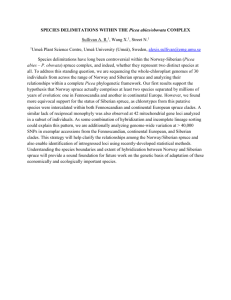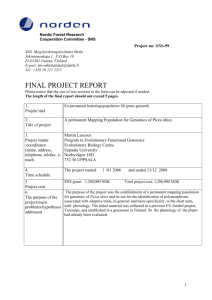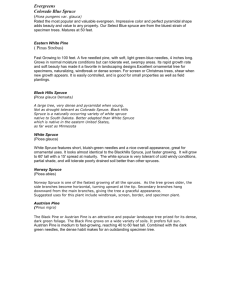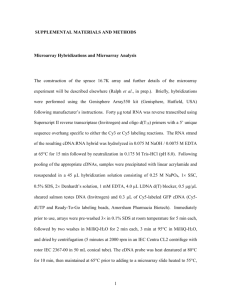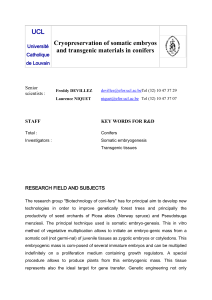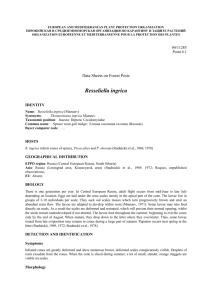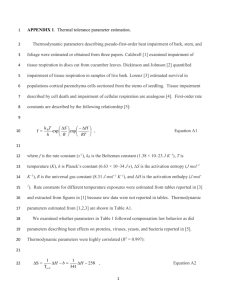Effect of Ecosystem Disturbance on Diversity of Bark and Wood- Scolytidae, Buprestidae,
advertisement
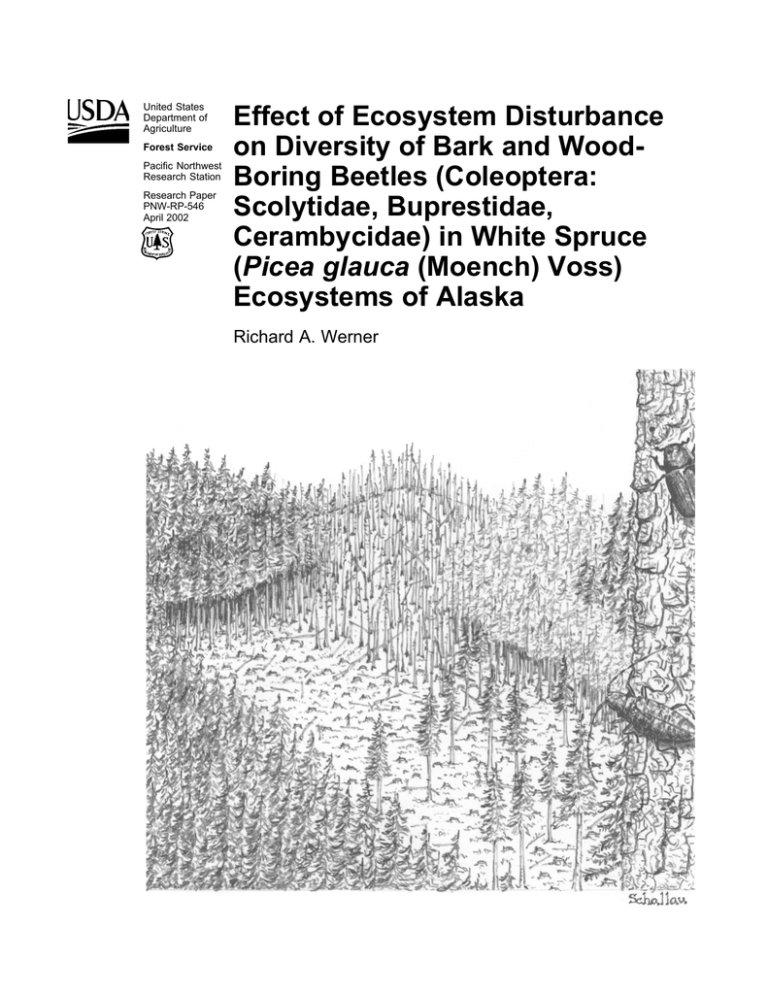
United States Department of Agriculture Forest Service Pacific Northwest Research Station Research Paper PNW-RP-546 April 2002 Effect of Ecosystem Disturbance on Diversity of Bark and WoodBoring Beetles (Coleoptera: Scolytidae, Buprestidae, Cerambycidae) in White Spruce (Picea glauca (Moench) Voss) Ecosystems of Alaska Richard A. Werner This publication reports research involving pesticides. It does not contain recommendations for their use, nor does it imply that the uses discussed here have been registered. All uses of pesticides must be registered by appropriate state and federal agencies, or both, before they can be recommended. CAUTION: Pesticides can be injurious to humans, domestic animals, desirable plants, and fish or other wildlife—if they are not handled or applied properly. Use all pesticides selectively and carefully. Follow recommended practices for the disposal of surplus pesticides and pesticide containers. Author Richard A. Werner was a research entomologist (retired), Pacific Northwest Research Station, 8080 NW Ridgewood Drive, Corvallis, OR 97330. He is currently a volunteer at the Pacific Northwest Research Station conducting research for the Long Term Ecological Research Program in Alaska. Abstract Werner, Richard A. 2002. Effect of ecosystem disturbance on diversity of bark and wood-boring beetles (Coleoptera: Scolytidae, Buprestidae, Cerambycidae) in white spruce (Picea glauca (Moench) Voss) ecosystems of Alaska. Res. Pap. PNW-RP-546. Portland, OR: U.S. Department of Agriculture, Forest Service, Pacific Northwest Research Station. 15 p. Fire and timber harvest are the two major disturbances that alter forest ecosystems in interior Alaska. Both types of disturbance provide habitats that attract wood borers and bark beetles the first year after the disturbance, but populations then decrease to levels below those in undisturbed sites. Populations of scolytids, buprestids, and cerambycids are compared 1, 5, and 10 years after burning and timber harvest on flood-plain and upland white spruce sites. This paper reports the effects of ecosystem disturbance, such as silvicultural practices and prescribed fire, on the diversity of wood-inhabiting bark beetles and wood borers in upland and flood-plain white spruce stands in interior Alaska. Keywords: Bark beetles, wood borers, prescribed fire, timber harvest, silvicultural practices, white spruce, Picea glauca. Summary Contents Data from 15 years of field work on the effects of ecosystem disturbance on populations of wood-boring beetles (Buprestidae and Cerambycidae) and bark beetles (Scolytidae) are summarized. Twenty-eight species of cerambycids were caught in upland sites compared to 21 species in flood-plain sites; 12 species of buprestids were caught in the upland sites and 8 species in the flood-plain sites. Twenty species of scolytids were found in the upland sites and 21 species in flood-plain sites. Species lists of insect and vegetation are provided by site and length of time after disturbance. 1 Introduction 2 Materials and Methods 2 Study Site Descriptions 2 Flood-Plain Forest Type 2 Upland Forest Type 2 Experimental Design 4 Trapping Method and Semiochemical Descriptions 4 Statistical Analysis 5 Results and Discussion 12 Conclusions 12 Acknowledgments 13 English Equivalents 13 Literature Cited This page has been left blank intentionally. Document continues on next page. Introduction The boreal forests of interior Alaska are a mosaic of vegetation types that are the result of wildfires and characteristics of aspect, slope, elevation, drainage, and soil. Biological diversity and distribution of species within communities depend on the above characteristics. The distribution of terrestrial species of vertebrates and invertebrates depends on plant species and the vertical distribution of the plants within the communities (Werner 1996). Boreal ecosystems are constantly undergoing change, and the long-term productivity of these ecosystems within the context of ecosystem management must be monitored to assure sustainable biodiversity. Changes in the health of forest ecosystems and the effects of ecosystem management can be measured by changes in the density, species composition, range, and behavior of terrestrial insect populations (Werner 1996). The information reported in this paper is part of a larger study monitoring terrestrial insect populations in various ecosystems over time with emphasis on the effects of disturbance on the composition and density of species inhabiting white spruce ecosystems in interior Alaska (Werner 1994a). A report (Werner 1983) on the diversity of boreal forest arthropods for six types of vegetation in interior Alaska found four taxonomic classes representing 94 arthropod families at the herb, shrub, and tree levels in undisturbed stands of quaking aspen (Populus tremuloides Michx.), balsam poplar (P. balsamifera L.), paper birch (Betula papyrifera Marsh.), white spruce (Picea glauca (Moench) Voss), and black spruce (P. mariana (Mill.) B.S.P.)). Ground herbs contained the highest densities of arthropods. In another study, Werner and Holsten (1984) monitored species diversity of scolytids associated with stands of white spruce at three geographically different sites in Alaska. They report 27 species in the Fairbanks, Alaska, area (lat. 64°37' N.), 22 species in the Brooks Range of Alaska (lat. 68°15' N.), and 20 species in the Kenai Peninsula area of Alaska (lat. 60°37' N.). Scolytids were found inhabiting all portions of the tree from the roots to small-diameter branches with the highest density in the tree bole. Werner (1979) reports on the effect of fire on arthropod density for ground inhabiting species in burned and unburned stands of black spruce. Arthropod density was lowest in the burned areas in the first 2 years after the fire; density of predatory spiders, however, increased during this time. Diversity of wood borer species is associated with various silvicultural practices in white spruce stands (Post 1984, Post and Werner 1988) and in the fringe areas surrounding recent wildfires (Werner and Post 1985). In these sites, Monochamus scutellatus (Say) and buprestid populations were higher in clearcut areas than in thinned or shelterwood areas; species of Tetropium were more abundant in partially shaded, thinned stands. Wood-boring beetles (Buprestidae and Cerambycidae) are commonly associated with stressed or dying white spruce in Alaska (Holsten and others 1980, Post 1984, Post and Werner 1988). Several species of wood borers have been associated with white spruce in interior British Columbia and western Canada (Cerezke 1977, Rose 1957, Ross 1960, Ross and Vanderwal 1969). Trees that are freshly cut, windthrown, or burned by fire are susceptible to attack by wood borers. These insects may be considered beneficial to forest ecosystems through their important role in the initial decomposition of logging slash. Wood borers, however, can cause economic losses in the form of wood degrade and volume loss when trees destined for commercial use are heavily infested (Post 1984). 1 This paper reports the effects of various silvicultural practices and prescribed fire on the diversity of wood-inhabiting scolytid, buprestid, and cerambycid beetles in floodplain and upland white spruce sites in interior Alaska. Materials and Methods Study Site Descriptions This study was conducted in the Bonanza Creek Experimental Forest, 32 km west of Fairbanks, Alaska. Study sites were located in flood-plain and upland stands of white spruce. Each site consisted of clearcuts, shelterwood logged stands, burned stands, fringe areas of burned stands, and undisturbed control stands. The burned stands were further subdivided into heavily burned stands with no live trees or ground cover after the burn, and lightly burned stands in the fringe areas surrounding the burned stands. The fringe areas contained white spruce that exhibited smoke damage to the needles and had less than 10 percent of the tree roots and trunk scorched. These stands also had less than 10 percent of the ground cover burned. Sites were located within 1 to 2 km of each other in an upland and a flood-plain area with similar topographical and vegetation characteristics. Flood-Plain Forest Type The forest type of the flood-plain sites prior to disturbance was represented by a closed white spruce/prickly rose-viburnum/twinflower/feather moss community (table 1) (Dyrness and others 1988). This 100-year-old mature stand of white spruce had an average tree diameter of 30 cm (at breast height) and an average height of 30 m. Basal area ranged from 30 to 60 m2 per ha. Stands were located in a low, flat area at an elevation of 122 m and were composed of white spruce (1,000 trees/ha), balsam poplar (81 trees/ha), paper birch (60 trees/ha), and tamarack (Larix laricina (Du Roi) K. Koch) (5 trees/ha). Tall shrub cover consisted of prickly rose (Rosa acicularis Lindl.), thinleaf alder (Alnus tenufolia Nutt.), American green alder (A. crispa (Ait.) Pursh), and highbush cranberry (Viburnum edule (Michx.) Raf.). Low shrubs provided less than 20percent cover and consisted of Arctostaphylos rubra (Rehd. and Wilson) Fern., Linnaea borealis L., Potentilla fructicosa L. and Vaccinium vitis-idaea L., Blue joint grass (Calamagrostis canadensis (Michx.) Beauv.) was also present. Mean daily temperature from June 1 to August 31 is 14.5 °C; mean weekly rainfall is 6.0 cm (Slaughter and Viereck 1986). Upland Forest Type The upland site prior to disturbance was a 165-year-old mature white spruce stand on a south slope at an elevation of 300 to 400 m (table 1). This stand was comprised primarily of white spruce (875 trees/ha), but paper birch (22 trees/ha) and quaking aspen (15 trees/ha) were also present (Viereck and others 1986). Shrub cover included Alnus spp., R. acicularis, Salix spp., Viburnum edule, L. borealis, and Vaccinium vitis-idaea along with Calamagrostis canadensis. Mean daily temperature from June 1 to August 31 is 16.3 °C; mean weekly rainfall is 5.2 cm (Slaughter and Viereck 1986). Experimental Design Two plots, each consisting of two 168-m transects, were established in each of the disturbed and undisturbed control stands (replicated twice) in the two study areas the same year the stands were either logged or burned, and the plots were monitored 1, 5, and 10 years following disturbance. Plots were spaced 300 m apart within each site and were located a minimum of 100 m from the edge of the site. Transects were aligned in a north-south and an east-west direction and crossed at midpoint. Four permanent vegetation plots were established in each of the two plots per site except for the burned fringe site. Vegetation plots were 1 m2 and were located 42 m from the midpoint of the transects. 2 Table 1—Plant species composition of upland and flood-plain white spruce plots at 1, 5, and 10 years post-disturbance, Fairbanks, Alaska Plot Species composition Control Year 1 5 10 Clearcut Year 1 5 10 Shelterwood Year 1 5 10 Burned Year 1 5 10 Percent cover Upland: Overstory— Betula papyrifera Marsh. Picea glauca (Moench) Voss Populus tremuloides Michx. Tall shrubs— Alnus spp. Rosa acicularis Lindl. Salix spp. Viburnum edule (Michx.) Raf. Low shrubs— Linnaea borealis L. Vaccinium vitis-idaea L. Grasses— Calamagrostis canadensis (Michx.) Beauv. Flood plain: Overstory— Betula papyrifera Marsh Larix laricina (Du Roi) K. Koch) Picea glauca (Moench) Voss Populus balsamifera L. Tall shrubs— Alnus spp. Rosa acicularis Lindl. Salix spp. Viburnum edule (Michx.) Raf. Low shrubs— Arctostaphylos rubra (Rehd.& Wilson) Linnaea borealis L. Potentilla fruticosa L. Vaccinium vitis-idaea L. Grasses: Calamagrostis canadensis (Michx.) Beauv. 10 85 5 10 85 5 10 85 5 5 0 25 10 5 55 15 5 55 0 50 10 5 5 50 50 15 15 0 0 0 25 35 0 5 60 30 5 20 5 20 5 20 5 20 5 20 5 20 5 10 5 10 15 10 10 15 15 5 10 15 5 15 5 15 10 20 10 20 10 20 10 20 0 50 15 20 5 40 30 20 15 15 15 15 15 15 5 5 5 10 5 10 10 10 10 5 15 15 25 5 15 15 15 15 0 0 0 20 65 45 10 15 5 20 40 55 5 5 80 10 5 5 80 10 5 5 80 10 50 0 40 0 50 5 40 5 50 5 40 5 0 0 100 0 5 5 0 0 95 95 0 0 0 0 0 0 30 35 5 5 5 25 5 15 75 90 5 10 75 90 5 10 75 90 5 10 40 85 5 25 40 90 5 25 35 80 5 15 45 85 20 40 50 50 95 50 5 5 55 5 0 7 5 20 5 70 0 10 5 70 0 10 5 65 0 10 5 45 0 10 5 45 0 10 5 40 0 10 5 60 5 0 5 5 60 45 5 5 0 5 0 0 0 5 5 5 5 10 15 20 10 15 20 0 15 75 55 20 15 20 30 15 15 65 55 15 5 5 10 10 5 9 5 5 5 5 3 Vegetation on the flood-plain plots was inventoried in 1984, 1 year after logging and prescribed fire, by using techniques developed by Ohmann and Ream (1971). Upland vegetation plots were established in 1977 in clearcut, shelterwood, and unmanaged control areas, and in 1983 in burned areas. Vegetation on these plots was measured at 1, 5, and 10 years after treatment. Trapping Method and Semiochemical Descriptions Cylindrical sticky traps (Kline and others 1974) baited with synthetic semiochemicals and 38 by 38 cm glass window traps were alternated at 15-m intervals along each transect. Cylindrical traps measured 45 cm in length and 25 cm in diameter and were constructed from 6.35-mm mesh wire screen. Traps were placed in clusters of five at each 15-m interval. Traps within clusters were spaced at 2-m intervals to form a circle. One cylindrical trap was baited with α-pinene and frontalin to capture Dendroctonus rufipennis and species of Polygraphus, Dryocoetes, Carphoborus, Cryphalus, Crypturgus, Orthotomicus, Phloeosinus, Phloeotribus, Pityophthorus, Scierus, Scolytus, and Trypodendrum (Werner 1994b, Werner and Holsten 1995). Another trap was baited with α-pinene and seudenol to catch Dendroctonus simplex (Werner 1994b). The third cylindrical trap was baited with α-pinene and ipsdienol to catch species of Ips (Werner 1993). The fourth trap was baited with α-pinene and turpentine to catch buprestids and cerambycids based on previous field tests and the fifth trap with α-pinene and sulcatol to catch species of Trypodendrum. Semiochemicals were purchased commercially from Aldrich Chemical Company, and releasers were prepared in the laboratory for the study before 1984. Chemical chirality, purity, release rates, and releaser devices were as follows: α-pinene, (-)-emantiomer, >99-percent pure, 0.7 mg/day, in closed polyethylene microcentrifuge tubes; frontalin, (R)-(-)- emantiomer, >99-percent pure, 0.1 mg/day, in eppendorf vials; racemic ipsdienol, 99-percent pure, 0.2 mg/day, in eppendorf vials; and sulcatol, 98.5 percent, polyethylene microcentrifuge tubes. Cylindrical sticky traps and window traps were attached to iron posts and placed 1.5 m above ground level. Twelve-unit funnel traps (Lindgren 1983) replaced cylindrical sticky traps in 1984, and semiochemicals were purchased from Phero Tech Inc., Delta, British Columbia.1 Funnel traps were hung from L-shaped iron posts with the bottom of the trap 0.5 m from the ground. Beetles were removed from traps and counted weekly between late May and mid-August. Scolytids were identified according to Wood (1963, 1982) and Bright (1976); buprestids according to Bright (1987); and cerambycids according to Linsley (1962). Statistical Analysis Weekly mean numbers of buprestids and cerambycids were compared between plots in a site and between sites by trapping method; i.e., funnel traps versus window traps. Non-normality was corrected for all trap counts and window trap data that were transformed by log10 (x+1) before analysis of variance (ANOVA), and if P < 0.05, comparison of means was calculated by the least significant difference (LSD) test (Zar 1984) by using SAS (SAS Institute 1990). The use of tade or firm names in this publication is for reader information and does not imply endorsement by the U.S. Department of Agriculture of any product or service. 1 4 Results and Discussion Wood borers and bark beetles were found inhabiting both disturbed and undisturbed sites of the white spruce ecosystem. Upland stands contained higher populations of cerambycids and buprestids 1 year after disturbance than flood-plain sites; however, there was no difference in beetle density between these sites 10 years after disturbance (table 2) even though the percentage of cover of white spruce decreased by 80 percent in clearcut sites and 35 percent in shelterwood sites (table 1). Flood-plain stands contained higher populations of scolytids than upland sites at 1, 5, and 10 years after disturbance. This difference can probably be attributed to a higher residual population of white spruce in the clearcut and shelterwood areas within the flood-plain sites compared to the upland sites (table 1). Logged spruce stands attract bark beetles and provide breeding sites in trees injured during logging and in recently cut stumps (Beckwith 1972, Beckwith and others 1977, Safranyik 1978). One year after disturbance, significantly more cerambycids were caught in the fringe sites of upland stands than in other study sites in both upland and flood-plain stands (table 3). Shelterwood sites also contained high populations of cerambycids 1 year after disturbance; few cerambycids were caught, however, in the burned and clearcut sites of upland and flood-plain stands 1, 5, and 10 years after disturbance. The floodplain shelterwood site had more cerambycids both 5 and 10 years after disturbance than any other upland or flood-plain site. Most buprestids were caught in the fringe and burned sites 1 year after disturbance; however, high densities were also present in the upland shelterwood site after 1 year. Most sites had low populations of buprestids 5 and 10 years after disturbance in both upland and flood-plain stands. This information supports previous reports of the attraction of buprestids to forest fires and recently burned areas of boreal forests (Evans 1972, 1973; Parmelee 1941; Werner and Post 1985). The number of scolytids trapped was highest in the undisturbed control site of the flood-plain stands 1 year after the other sites were disturbed (table 3). High numbers of scolytids also were caught in the upland and flood-plain fringe and clearcut sites 1 year after disturbance. Werner and Post (1985) also report high populations of wood borers and bark beetles in the fringe areas surrounding recently burned stands of white spruce in interior Alaska. Burned sites had the lowest populations of scolytids throughout the study. Semiochemical-baited traps caught more cerambycids, buprestids, and scolytids than window traps in all study sites (table 3). Window traps could have caught some beetles that were flying to semiochemical-baited traps because beetles respond directly to specific semiochemicals compared to being caught in window traps during random flight. Twenty-eight species of cerambycids were caught in upland stands compared to 21 species in flood-plain stands (tables 4 and 5). Species of Acmaeops, Anoplodera, Callidium, Gnathacmaeops, Neoclytus, and Xylotrechus were caught only during the first year after disturbance; other species were caught at 1 year and either at 5 or 10 years after disturbance (tables 4 and 5). Nineteen species of cerambycids were caught in the undisturbed upland site compared with five species in the undisturbed flood-plain site. This difference can probably be attributed to the higher percentage of snow-damaged spruce on the undisturbed upland site. White spruce damaged by ice and snow is 5 6 1 5 10 a 735 + 60a 585 + 44b 1 10 113 + 15a 125 + 17a 137 + 16a 121 + 15a 5 Buprestidae Year 3,296 + 291b 6,208 + 442a 1 10 1,408 + 119b 1,438 + 123b 2,163 + 192a 1,974 + 174a 5 Scolytidae Year Mean values within each column for each year followed by the same letter are not significantly different (P < 0.05) LSD test (Zar 1984). Upland 821 + 58a 274 + 25a 259 + 27a Flood plain 414 + 33b 290 + 28b 283 + 24a Site Cerambycidae Year Beetles caughta Table 2—Mean (+ SEM) number of wood borers and bark beetles in upland and flood-plain stands of white spruce in interior Alaska in years 1, 5, and 10 postdisturbance 7 a 17 32 24 36 41 21 42 31 44 37 Flood plain: Burned Fringe Clearcut Shelterwood Control 10 54 25 67 33 Flood plain: Burned Fringe Clearcut Shelterwood Control Upland: Burned Fringe Clearcut Shelterwood Control 7 62 15 43 50 + + + + + + + + + + + + + + + + + + + + 2e 4d 3d 5d 4d 2e 4d 3e 3d 5d 1e 4d 2e 6d 3d 1e 6d 2e 4d 5d 59 + 6d 221 + 25b 27 + 4e 95 + 11c 88 + 9c Flood plain: Burned Fringe Clearcut Shelterwood Control Upland: Burned Fringe Clearcut Shelterwood Control 56 + 5d 322 + 31a 55 + 4d 107 + 15c 37 + 2d Upland: Burned Fringe Clearcut Shelterwood Control Site Pheromone traps 13 26 21 26 22 20 23 16 26 24 10 31 13 44 21 11 24 9 22 31 28 89 42 29 16 + + + + + + + + + + + + + + + + + + + + + + + + + 1d 3c 3c 4c 3c 2c 3c 3d 3c 2c 1d 3c 1d 4c 2c 2d 2c 1d 2c 3c 2c 8b 4c 3c 1d 36 + 3c 129 + 16a 28 + 1c 30 + 2c 21 + 2c Cerambycidae Window traps + 2e + 10d + 2e + 5d + 9d 34 68 52 70 59 37 55 40 62 65 + + + + + + + + + + 3e 7d 6d 8d 5d 6e 5d 4e 5d 6d 20 + 2e 85 + 8d 38 + 4e 111 + 12c 36 + 4e 18 86 24 65 81 87 + 12d 310 + 28b 69 + 6d 124 + 14c 104 + 11c 92 + 14d 451 + 41a 83 + 9d 137 + 15c 58 + 4d Total 6 13 19 21 18 11 9 15 14 19 3 15 24 29 20 10 13 8 20 15 + + + + + + + + + + + + + + + + + + + + 1e 1e 2e 2d 2e 1e 1e 2e 2e 2e 1e 2e 2d 3d 2d 1e 1e 1e 2d 2e 111 + 13c 152 + 17b 26 + 2d 85 + 10d 18 + 2e 134 + 15b 199 + 22a 20 + 2d 152 + 19b 45 + 3d 9 5 7 11 12 8 8 5 11 25 0 10 11 14 11 7 16 4 11 9 84 62 11 24 12 46 72 11 31 25 + 1d + 1d + 1d + 1d + 1d + 1d + 1d + 1d + 1d + 3c + 0d + 1d + 1d + 1d + 1d + 1d + 2d + 1d + 1d + 1d + 9a + 5a + 1d + 2c + 1d + 4b + 7a + 1d + 3b + 3c Beetles caughta Buprestidae Pheromone Window traps traps 15 18 26 32 30 19 17 20 25 44 3 25 35 43 31 17 29 12 31 24 + + + + + + + + + + + + + + + + + + + + 2e 2e 3d 4d 4d 2e 2e 2e 3d 4d 1e 3d 4d 4d 3d 2e 3d 1e 3d 2d 195 + 21b 214 + 24a 37 + 3d 109 + 12c 30 + 3c 180 + 18b 271 + 27a 31 + 2d 183 + 20b 70 + 8c Total + + + + + 3g 65c 60c 43d 31e 17 425 123 135 562 21 327 99 216 301 22 579 132 156 621 16 369 112 194 269 + + + + + + + + + + + + + + + + + + + + 2g 35d 16f 18f 39d 2g 31e 13f 23e 27e 3g 40d 17f 19f 46d 2g 35e 16f 23g 26e 67 + 7f 1,575 + 121b 899 + 73c 294 + 28e 2,139 + 187a 41 876 841 594 215 Pheromone traps Mean values within each column for each year followed by the same letter are not significantly different (P < 0.05) LSD test (Zar 1984). 10 5 1 Years after disturbance 9 + 1f 269 + 31c 46 + 4e 53 + 4e 335 + 34b 14 + 1f 157 + 22d 52 + 5e 98 + 11d 153 + 21d 8 + 1f 231 + 26c 67 + 7e 85 + 9d 262 + 29c 11 + 1f 123 + 18c 76 + 10e 93 + 12d 145 + 19d 32 + 2e 322 + 30b 296 + 29b 97 + 14d 487 + 44a 15 + 2f 293 + 29b 225 + 24c 151 + 16d 45 + 3e Scolytidae Window traps 26 694 169 188 897 35 484 151 314 454 30 810 199 241 883 27 492 188 287 414 + 3f + 51d + 21e + 24e + 77c + 4f + 38d + 22e + 31d + 38d + 3f + 54c + 23e + 25e + 72c + 3f + 35d + 24e + 28e + 34d 99 + 11e 1,897 + 179b 1,195 + 130b 391 + 37d 2,626 + 223a 56 + 5f 1,169 + 134b 1,066 + 113b 745 + 64c 260 + 25e Total Table 3—Mean (+ SEM) number of wood borers and bark beetles caught in semiochemical-baited traps and window traps in disturbed and undisturbed sites on upland and flood-plain stands of white spruce in interior Alaska highly attractive to wood borer and bark beetle attack 1 to 2 years after damage has occurred (Werner 1993). Werner and Post (1985) report the capture of Monochamus scutellatus and Tetropium spp. in the burned and fringe areas associated with a wildfire in interior Alaska. They also note that these species primarily attacked partially burned white spruce in these areas. Twelve species of buprestids were caught in the upland sites and eight species in the flood-plain sites (tables 4 and 5). Fewer than 50 percent of these buprestids were caught in undisturbed upland and flood-plain sites (table 3), indicating that buprestids are attracted primarily to disturbed sites. All species of buprestids were caught either 1 or 5 years after disturbance in burned, fringe, clearcut, and shelterwood sites of both upland and flood-plain stands. Werner and Post (1985) found Oxypteris acuminata and Melanophila drummondi feeding in the roots and lower portions of the trunk of partially burned white spruce in upland stands. Twenty species of scolytids were found in upland sites and 21 species in flood-plain sites (tables 6 and 7). Nineteen species were found in undisturbed control sites of both upland and flood-plain stands. This is fewer than the 27 species caught in semiochemical-baited traps and trap trees in undisturbed sites in the Fairbanks area (Werner and Holsten 1984). Fewer species were caught in burned sites than in fringe, clearcut, shelterwood, and control sites. Species of Dendroctonus, Dryocoetes, Ips, Orthotomicus, Scierus, Scolytus, and Trypodendrum were caught in burned sites 1 year after disturbance. Werner and Post (1985) report Dendroctonus rufipennis, Ips spp., and T. lineatum as the major scolytids in burned and fringe sites following disturbance. Beckwith (1972) reports that Dryocoetes affaber and Ips spp. accounted for 80 percent of the scolytids collected in window traps in thinned stands of upland white spruce in the Fairbanks area. He also found Scolytus piceae only in thinned stands, whereas it was found in all sites in this study. In this study, Ips perturbatus was caught in greater numbers than other species in all study sites. Fire removes most host trees that normally would be inhabited by scolytid and cerambycid beetles, but the scorched trees provide excellent habitat for buprestid species the first year after burning. The effects of fire are long-lasting, and few bark and wood-boring beetles are found inhabiting burned areas 5 and 10 years after the initial disturbance because burned spruce ecosystems usually are replaced by hardwood species. The effects of fire, however, are beneficial in providing habitat for populations of cerambycids and scolytids in the fringe areas surrounding the severely burned areas. Partially burned trunks and roots of spruce are intensively infested with these beetles during the first year of burning and, up to 15 years after burning, continue to maintain high populations of scolytids, but not buprestids or cerambycids. The effects of timber harvest are notable in clearcut areas where populations of wood borers are significantly reduced but where populations of scolytids increase the first year after logging. Shelterwood areas provide increased habitat for wood borers and scolytids for 1 year after logging, but populations decline thereafter. Both types of disturbance provide habitats that attract wood borers and bark beetles the first year after the disturbance, but populations then decrease to levels below those in undisturbed sites. 8 Table 4—List of wood borers caught in upland white spruce sites by years after disturbance Years after disturbance Families and species Cerambycidae: Acmaeops pratensis Laichartig Acmaeops proteus proteus (Kirby) Anoplodera canadensis (Olivier) Arhopalus productus (LeConte) Callidium cicatricosum Mannerheim Dorcasta sp. Evodinus monticola vancouveri Casey Gnathacmaeops pratensis (Laichartig) Grammoptera subargentata (Kirby) Judolia montivagans montivagans (Couper) Leptura propinqua Bland Meacanthocinus pusillus (Kirby) Meriellum proteus (Kirby) Monochamus scutellus (Say) Monochamus oregonensis LeConte Neoclytus muricatulus muricatulus (Kirby) Neacanthocinus pusillus Kirby Pachyta lamed (L.) Pachyta lamed liturata Kirby Pogonocherus mixtus Haldeman Pogonocherus penicillatus LeConte Pronocera collaris (Kirby) Pronocera collaris collaris (Kirby) Phymatodes dimidiatus (Kirby) Semanotus litigious (Casey) Tetropium cinnamopterum parvulum Casey Trachysida asperda asperda (LeConte) Xylotrechus undulatus (Say) Buprestidae: Agrilus anxius Gory Agrilus politus (Say) Anthaxia inornata (Randall) Anthaxia retifer LeConte Buprestis nuttalli Kirby Chrysobothris trinervia (Kirby) Dicera callosa callosa Casey Dicera tenebrica Kirby Dicera tenebrosa Kirby Melanophila drummondi (Kirby) Melanophila fulvoguttata (Harris) Oxypteris acuminata (De Geer) Host Picea Picea Picea Picea Picea Picea Populus Picea Populus Picea Picea Picea Picea Picea Picea Picea Picea Picea Picea Picea Picea Picea Picea Picea Picea Picea Picea Picea Betula Salix Picea Picea Picea Picea Populus Populus Picea Picea Picea Picea Burned 1 Fringe Clearcut 1 1 1 1 1, 5 1 1 1 1, 5 1, 5 1, 5 1, 5 Shelterwood Control 1 1 1 1, 5 1, 5 1, 5 1, 5 1, 5 1 1 1 1, 5 1 1 1, 5 1, 5 1 1 1, 5 1 1, 5 1 1 1 1 1 1 1, 5 1, 5 1 1, 5 1, 5 1 1, 5 1 1 1, 5 1 1 1, 5 1 1, 5 1, 5 1, 5 1, 5 1 1, 5 1, 5 1, 5 1, 5 1, 5 1, 5, 10 1, 5, 10 1, 5, 10 1, 5, 10 1, 5, 10 1, 5, 10 1, 5, 10 1 1, 5, 10 1, 5, 10 1, 5, 10 1, 5 1, 5 1, 5 1, 5 1, 5 1, 5 1 1, 5 1, 5 1, 5 1, 5, 10 1, 5, 10 1, 5, 10 1, 5, 10 1, 5 1, 5 1 1 1, 5 1, 5 1, 5 1, 5 1, 5 1, 5 1, 5 1, 5, 10 1, 5, 10 1, 5, 10 1, 5, 10 1, 5, 10 1, 5, 10 1, 5, 10 1, 5, 10 9 Table 5—List of wood borers caught in flood-plain white spruce sites by years after disturbance Years after disturbance Families and species Cerambycidae: Acmaeops pratensis Laichartig Acmaeops proteus proteus (Kirby) Anoplodera canadensis (Olivier) Arhopalus productus (LeConte) Callidium cicatricosum Mannerheim Gnathacmaeops pratensis (Laichartig) Meriellum proteus (Kirby) Monochamus scutellus (Say) Monochamus oregonensis LeConte Neoclytus muricatulus muricatulus (Kirby) Pachyta lamed (L.) Pachyta lamed liturata Kirby Pogonocherus mixtus Haldeman Pogonocherus penicillatus LeConte Pronocera collaris (Kirby) Pronocera collaris collaris (Kirby) Phymatodes dimidiatus (Kirby) Semanotus litigious (Casey) Tetropium cinnamopterum parvulum Casey Tetropium velutinum LeConte Xylotrechus undulatus (Say) Buprestidae: Agrilus politus (Say) Anthaxia inornata (Randall) Buprestis nuttalli Kirby Chrysobothris trinervia (Kirby) Dicera tenebrosa Kirby Melanophila drummondi (Kirby) Melanophila fulvoguttata (Harris) Oxypteris accuminata (De Geer) 10 Host Picea Picea Picea Picea Picea Picea Picea Picea Picea Larix Picea Picea Larix Larix Picea Picea Picea Larix Picea Larix Picea Salix Picea Picea Picea Picea Picea Picea Picea Burned Fringe 1 1 1 1 1 1, 5 1 1 1, 5 1, 5, 10 1 1 1, 5 1, 5 Clearcut 1 1 1 1 1 1, 5, 10 1, 5 1 Shelterwood Control 1 1 1 1, 5 1 1, 5 1, 5, 10 1, 5 1 1, 5 1, 5 1 1 1 1 1, 5 1, 5 1, 5 1, 5 1 1 1 1 1, 5 1, 5 1, 5 1, 5 1, 5 1, 5 1, 5 1 1, 5 1 1, 5 1, 5 1, 5 1, 5 1, 5 1, 5 1, 5 1, 5 1, 5 1, 5 1, 5 1 1, 5 1 1, 5 1, 5 1, 5 1, 5 1, 5 1, 5, 10 1, 5, 10 1, 5, 10 1, 5, 10 1, 5, 10 1, 5 1, 5, 10 Table 6—List of scolytid bark beetles caught in upland white spruce sites by years after disturbance Years after disturbance Species Host Carphoborus andersoni Swaine Carphoborus carri Swaine Cryphalus ruficollis ruficollis Hopkins Crypturgus borealis Swaine Dendroctonus rufipennis (Kirby) Dendroctonus simplex LeConte Dryocoetes affaber (Mannerheim) Dryocoetes autographus (Ratzeburg) Ips borealis borealis Swaine Ips perturbatus (Eichhoff) Ips tridens tridens (Mannerheim) Orthotomicus caelatus (Eichhoff) Phloeosinus pini Swaine Phloeotribus picea Swaine Pityophthorus spp. Polygraphus rufipennis (Kirby) Scierus annectans LeConte Scolytus piceae (Swaine) Trypodendrum lineatum (Olivier) Xylechinus montanus Blackman Picea Picea Picea Picea Picea Picea Picea Picea Picea Picea Picea Picea Picea Picea Picea Picea Picea Picea Picea Picea Burned 1 1 1 1 1 1 1 1 1 Fringe Clearcut Shelterwood Control 1, 5 1, 5 1, 5, 10 1, 5, 10 1, 5 1, 5 1 1 1 1, 5 1 1, 5 1 1 1, 5 1 1, 5 1, 5, 10 1, 5, 10 1 1 1, 5, 10 1 1, 5, 10 1, 5, 10 1, 5, 10 1, 5, 10 1, 5, 10 1, 5, 10 1, 5 1, 5 1, 5 1, 5, 10 1, 5, 10 1 1 1, 5 1, 5 1, 5, 10 1, 5, 10 1 1, 5 1, 5, 10 1, 5 1, 5, 10 1, 5, 10 1, 5 1, 5, 10 1, 5, 10 1, 5, 10 1, 5, 10 1, 5, 10 1, 5, 10 1, 5, 10 1, 5, 10 1, 5, 10 1, 5, 10 1, 5, 10 1, 5, 10 1, 5, 10 1, 5, 10 1, 5, 10 1, 5, 10 1, 5, 10 1, 5, 10 1, 5, 10 11 Table 7—List of scolytid bark beetles caught in flood-plain white spruce sites by years after disturbance Years after disturbance Species Host Carphoborus carri Swaine Carphoborus intermedius Wood Cryphalus ruficollis ruficollis Hopkins Crypturgus borealis Swaine Dendroctonus rufipennis (Kirby) Dendroctonus simplex LeConte Dryocoetes affaber (Mannerheim) Dryocoetes autographus (Ratzeburg) Ips borealis borealis Swaine Ips perturbatus (Eichhoff) Ips tridens tridens (Mannerheim) Orthotomicus caelatus (Eichhoff) Phloeosinus pini Swaine Phloeotribus picea Swaine Pityophthorus spp. Polygraphus convexifrons Wood Polygraphus rufipennis (Kirby) Scierus annectans LeConte Scolytus piceae (Swaine) Trypodendrum lineatum (Olivier) Trypodendrum retusum (LeConte) Picea Picea Picea Picea Picea Picea Picea Picea Picea Picea Picea Picea Picea Picea Picea Picea Picea Picea Picea Picea Picea Burned 1 1 1 1 1 Fringe 1, 5 1 1 1 1, 5 1, 5, 10 1, 5, 10 1, 5, 10 1, 5, 10 1, 5, 10 1 1 1 1 1 1, 5, 10 1 1, 5, 10 1, 5, 10 Clearcut 1 1, 5 1, 5 1, 5 1, 5 1, 5 1 1, 5 1 1 1 1, 5 1 1, 5 1 1, 5, 10 1, 5 Shelterwood Control 1 1, 5, 10 1, 5, 10 1, 5, 10 1, 5, 10 1, 5, 10 1, 5, 10 1 1, 5, 10 1, 5 1, 5 1, 5, 10 1, 5, 10 1, 5, 10 1, 5, 10 1, 5, 10 1, 5, 10 1, 5, 10 1, 5, 10 1, 5, 10 1, 5, 10 1, 5, 10 1, 5 1, 5, 10 1, 5 1 1, 5, 10 1, 5, 10 1, 5, 10 1, 5, 10 1, 5, 10 Conclusions This study indicates that various disturbances of white spruce ecosystems in interior Alaska have a direct impact on the diversity of species of wood borer and scolytid bark beetles occurring in disturbed areas. Silvicultural practices such as clearcut and shelterwood harvest provide habitat for wood borers and bark beetles that inhabit logging slash and weakened residual trees. Likewise, the fringe areas of prescribed fire or wildfire provide host trees susceptible to bark beetle and cerambycid attack because of reduced resistance of the host tree caused by damage from smoke and heat. Acknowledgments I thank Joyce Beelman, Danny Lyon, Karen Post, Alan Robertson, Alan Rhode, and Steve Hall (all formerly with U.S. Department of Agriculture, Forest Service, Pacific Northwest Research Station, Fairbanks, AK) for maintenance of the research plots and collection of the beetles, and Tim Max (U.S. Department of Agriculture, Forest Service, Pacific Northwest Research Station, Portland, OR) for help in statistical analysis of the data. I am grateful to Donald E. Bright, Jr. (Biological Resources Division, Agriculture Canada, Ottawa) for identification of buprestids, cerambycids, and scolytids; and Stephen L. Wood (Brigham Young University, Provo, UT) for identification of scolytids. Thanks also to Donald E. Bright, Jr. and Edward H. Holsten (U.S. Department of Agriculture, Forest Service, Alaska Region, Forest Health Management, State and Private Forestry, Anchorage, AK) for their review of the manuscript. 12 English Equivalents Literature Cited When you know: Multiply by: To find: Celsius (°C) 1.8 and add 32 Fahrenheit Centimeters (cm) 2.54 Inches Hectares (ha) 2.47 Acres Kilometers (km) 0.621 Miles Meters (m) 3.281 Feet Millimeters (mm) 0.254 Inches Beckwith, R.C. 1972. Scolytid flight in white spruce stands in Alaska. Canadian Entomologist. 104: 1977-1983. Beckwith, R.C.; Wolff, J.O.; Zasada, J.C. 1977. Bark beetle response to clearcut and shelterwood systems in interior Alaska following whole tree logging. Res. Note PNW-RN-287. Portland, OR: U.S. Department of Agriculture, Forest Service, Pacific Northwest Research Station. 7 p. Bright, D.E. 1976. The insects and arachnids of Canada. Part 5: The bark beetles of Canada and Alaska—Coleoptera: Scolytidae. Publ. 1576. Ottawa, ON: Research Branch Agriculture Canada. [Pages unknown]. Bright, D.E. 1987. The insects and arachnids of Canada. Part 15: The metallic woodboring beetles of Canada and Alaska—Coleoptera: Buprestidae. Publ. 1810. Ottawa, ON: Research Branch Agriculture Canada. [Pages unknown]. Cerezke, H.F. 1977. Characteristics of tree damage in tree-length white spruce logs caused by the white-spotted sawyer, Monochamus scutellatus. Canadian Journal of Forest Research. 7: 232-240. Dyrness, C.T.; Viereck, L.A.; Foote, M.J.; Zasada, J.C. 1988. The effect of vegetation and soil temperature of logging flood-plain white spruce. Res. Pap. PNW-RP392. Portland, OR: U.S. Department of Agriculture, Forest Service, Pacific Northwest Forest and Range Experiment Station. 15 p. Evans, W.G. 1972. The attraction of insects to forest fires. In: Proceedings of the annual Tall Timbers fire ecology conference. Tallahassee, FL: Tall Timbers Research Station: 110-127. Vol. 10. Evans, W.G. 1973. Fire beetles and forest fires. Insect World Digest. 1: 14-17. Holsten, E.H.; Werner, R.A.; Laurent, T.H. 1980. Insects and diseases of Alaska forests. Rep. No. 75. Anchorage, AK: U.S. Department of Agriculture, Forest Service, Alaska Region. 187 p. Kline, L.N.; Schmitz, R.F.; Rudinsky, J.A.; Furniss, M.M. 1974. Repression of spruce beetle (Coleoptera) attraction by methylcyclohexenone in Idaho. Canadian Entomologist. 106: 485-491. Lindgren, B.S. 1983. A multiple funnel trap for scolytid beetles (Coleoptera: Scolytidae). Canadian Entomologist. 115: 289-294. Linsley, E.G. 1962. The Cerambycidae of North America. Part II: Taxonomy and classification of the Parandrinae, Prioninae, Spondylinae, and Aseminae. Berkeley, CA: University of California Press. Vol. 19. 13 Ohmann, L.L.; Ream, R.R. 1971. Wilderness ecology: a method of sampling and summarizing data for plant community classification. Res. Pap. NC-49. St. Paul, MN: U.S. Department of Agriculture, Forest Service, North Central Forest Experiment Station. 14 p. Parmelee, F.T. 1941. Longhorned and flatheaded borers attacking fire-killed coniferous timber in Michigan. Journal of Economic Entomology. 34: 377-380. Post, K.E. 1984. Wood borer (Cerambycidae and Buprestidae) infestation, development and impact on wood quality in recently felled white spruce trees in the interior of Alaska. Fairbanks, AK: University of Alaska Fairbanks. [Pages unknown]. M.S. thesis. Post, K.E.; Werner, R.A. 1988. Wood borer distribution and damage in decked white spruce logs. Northern Journal of Applied Forestry. 5: 49-51. Rose, A.H. 1957. Some notes on the biology of Monochamus scutellatus (Say) (Coleoptera: Cerambycidae). Canadian Entomologist. 89: 547-553. Ross, D.A. 1960. Damage by long-horned wood borers in fire-killed white spruce, central British Columbia. Forestry Chronicles. 36: 355-361. Ross, D.A.; Vanderwal, H.A. 1969. A spruce borer, Tetropium cinnamopterum Kirby, in interior British Columbia. Journal of the Entomological Society of British Columbia. 66: 10-14. Safranyik, L. 1978. Spruce beetle mortality in stumps following an operational broadcast burn. Canadian Forest Service Bi-Monthly Research Notes. 34: 7-8. SAS Institute. 1990. SAS procedures guide, version 6.0, 3rd ed. Cary, NC. Slaughter, C.W.; Viereck, L.A. 1986. Climatic characteristics of the taiga interior Alaska. In: Van Cleve, K. [and others], eds. Forest ecosystems in the Alaska taiga: a synthesis of structure and function. New York: Springer-Verlag: 9-21. Viereck, L.A.; Van Cleve, K.; Dyrness, C.T. 1986. Forest ecosystem distribution in the taiga environment. In: Van Cleve, K. [and others], eds. Forest ecosystems in the Alaska taiga: a synthesis of structure and function. New York: SpringerVerlag: 22-43. Werner, R.A. 1979. Effects of fire on arthropod distribution. In: Viereck, L.A.; Dyrness, C.T., tech. eds. Ecological effects of the Wickersham Dome fire near Fairbanks, Alaska. Gen. Tech. Rep. PNW-GTR-90. Portland, OR: U.S. Department of Agriculture, Forest Service, Pacific Northwest Research Station: 53. Werner, R.A. 1983. Biomass, density, and nutrient content of plant arthropods in the taiga of Alaska. Canadian Journal of Forest Research. 13: 729-739. Werner, R.A. 1993. Response of the engraver beetle, Ips perturbatus, to semiochemicals in white spruce stands of interior Alaska. Res. Pap. PNW-RP-465. Portland, OR: U.S. Department of Agriculture, Forest Service, Pacific Northwest Research Station. 9 p. Werner, R.A. 1994a. Forest insect research in boreal forests of Alaska. Entomology (Trends in Agricultural Sciences). 2: 35-46. 14 Werner, R.A. 1994b. Research on the use of semiochemicals to manage spruce beetles in Alaska. In: Shea, P, tech. ed. Proceedings of the symposium on management of western bark beetles with pheromones: research and development. Gen. Tech. Rep. PSW-150. Albany, CA: U.S. Department of Agriculture, Forest Service, Pacific Southwest Research Station: 15-21. Werner, R.A. 1996. Forest health in boreal ecosystems of Alaska. Forestry Chronicles. 72: 43-46. Werner, R.A.; Holsten, E.H. 1984. Scolytidae associated with felled white spruce in Alaska. Canadian Entomologist. 116: 465-471. Werner R.A.; Holsten, E.H. 1995. Current status of research with the spruce beetle, Dendroctonus rufipennis. In: Salom, S.M.; Hobson, K.R., tech. eds. Application of semiochemicals for management of bark beetle infestations: Proceedings of an informal conference. Gen. Tech. Rep. INT-318. Ogden, UT: U.S. Department of Agriculture, Forest Service, Intermountain Forest Research Station: 23-29. Werner, R.A.; Post, K.E. 1985. Effects of wood-boring insects and bark beetles on survival and growth of burned white spruce. In: Juday, J.P.; Dyrness, C.T., eds. Early results of the Rosie Creek fire research project 1984. Misc. Publ. 85-2. Fairbanks, AK: University of Alaska Fairbanks, Agriculture and Forestry Experiment Station: 14-16. Wood, S.L. 1963. A revision of the bark beetle genus Dendroctonus Erichson (Coleoptera: Scolytidae). Great Basin Naturalist. 23: 1-117. Wood, S.L. 1982. The bark and ambrosia beetles of North and Central America (Coleoptera: Scolytidae), a taxonomic monograph. Great Basin Naturalist Memoirs. 6: 1-1359. Zar, J.H. 1984. Biostatistical analysis. Englewood Cliff, NJ: Prentice Hall. 718 p. 15 This page has been left blank intentionally. Document continues on next page. This page has been left blank intentionally. Document continues on next page. This page has been left blank intentionally. Document continues on next page. The Forest Service of the U.S. Department of Agriculture is dedicated to the principle of multiple use management of the Nation’s forest resources for sustained yields of wood, water, forage, wildlife, and recreation. Through forestry research, cooperation with the States and private forest owners, and management of the National Forests and National Grasslands, it strives—as directed by Congress—to provide increasingly greater service to a growing Nation. The U.S. Department of Agriculture (USDA) prohibits discrimination in all its programs and activities on the basis of race, color, national origin, gender, religion, age, disability, political beliefs, sexual orientation, or marital or family status. (Not all prohibited bases apply to all programs.) Persons with disabilities who require alternative means for communication of program information (Braille, large print, audiotape, etc.) should contact USDA’s TARGET Center at (202) 720-2600 (voice and TDD). To file a complaint of discrimination, write USDA, Director, Office of Civil Rights, Room 326-W, Whitten Building, 14th and Independence Avenue, SW, Washington, DC 20250-9410 or call (202) 720-5964 (voice and TDD). USDA is an equal opportunity provider and employer. Pacific Northwest Research Station Web site Telephone Publication requests FAX E-mail Mailing address http://www.fs.fed.us/pnw (503) 808-2592 (503) 808-2138 (503) 808-2130 desmith@fs.fed.us Publications Distribution Pacific Northwest Research Station P.O. Box 3890 Portland, OR 97208-3890 U.S. Department of Agriculture Pacific Northwest Research Station 333 S.W. First Avenue P.O. Box 3890 Portland, OR 97208-3890 Official Business Penalty for Private Use, $300

